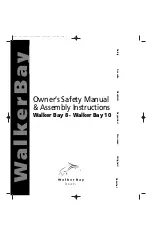
FIRE EXTINGUISHERS
As the boat owner, you are responsible for making sure you have
the required number of fire Extinguishers. Fire Extinguishers must
be approved by the U.S. Coast Guard.
Boats longer than 16 feet and shorter than 26 feet: At least one
portable hand Type B-1 fire extinguisher.
All fire Extinguishers should be mounted in a readily accessible loca-
tion away from the engine compartment. Everyone on board should
know where the fire Extinguishers are and how to operate them.
If your fire extinguisher has a charge indicator gauge, cold or hot
weather may affect the gauge reading. Consult the instruction man-
ual supplied with the fire extinguisher to determine the accuracy of
the gauge.
Automatic Fire Extinguisher
Note: A fire extinguishing system is available as optional
equipment.
The fire extinguishing system in the engine compartment uses a fire
extinguishing agent. In case of fire, the heat-sensitive automatic
nozzle releases agent as a vapor, totally filling the area with agent
to extinguish the fire.
The system’s indicator light at the helm is illuminated when the igni-
tion switch is on. When the system is discharged, the indicator light
will go out.
Allow agent to fill entire engine compartment for at least 15 minutes.
Hot metals or fuel can also begin cooling during this time.
Cautiously
inspect compartment for cause of fire and damage to
equipment. Have portable Extinguishers readily available.
Do not
breathe fumes or vapors caused by fire.
Note: See the manufacturer’s owner’s manual for detailed
information about safety precautions and procedures for oper-
ating and maintaining the fire extinguishing system. The
manual is in your owner’s packet.
WARNING:
If system discharges, immediately turn OFF engine
and electrical systems. Extinguish all smoking materials. Do not
open engine compartment. Fresh air supplies oxygen to fire and
fire may flash back through opening.
BILGE PUMP
Note: All models come equipped with an automatic bilge pump
that will activate when water accumulates in the bilge. There is
also a switch at the helm for manual activation.
The electric bilge pump removes water from the bilge area. If the pump
motor runs but does not remove any water, the pump may be clogged.
If there is no visible debris clogging the pump and water is still not
being removed, check the discharge hose for kinks or obstruction.
4-3
CAUTION:
Acceleration at full throttle is not recommended until
after the engine “break-in period.” This break-in period also
coincides with the engine 20-hour checkup.
WARNING
IN CASE OF FIRE DO NOT OPEN ENGINE
BOX OR COMPARTMENT. SHUT DOWN ENGINE,
GENERATOR, AND BLOWERS, CONTINUOUSLY
DISCHARGE ENTIRE CONTENTS OF AGENT
PORTABLE FIRE EXTINGUISHER THROUGH
PORT IMMEDIATELY.
DO NOT OPEN ENGINE BOX
Summary of Contents for 2012 H2O Series
Page 15: ...1 7...
Page 16: ......
Page 20: ......
Page 75: ......
Page 83: ......
Page 89: ......
Page 90: ...WIRING SCHEMATICS 12 12 1 H2O INST PNL PIGTAIL...
Page 91: ...12 2 H20 INST PNL PIGTAIL...
Page 92: ...12 3 H20 DECK DISTRIBUTION HARNESS...
Page 93: ...12 4 H20 DECK DISTRIBUTION HARNESS...
Page 94: ...12 5 H2O HULL DISTRIBUTION HARNESS...
Page 95: ...12 6 H20 OPTIONAL AERATOR DECK HARNESS...
Page 96: ...12 7 H2O OPTIONAL AERATOR HULL HARNESS...
















































